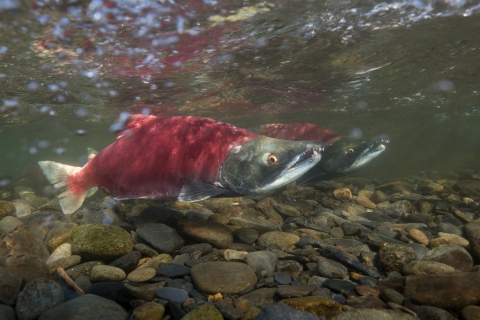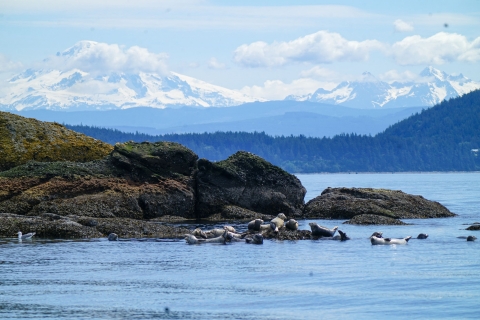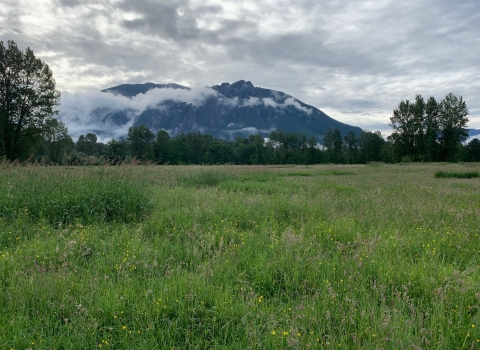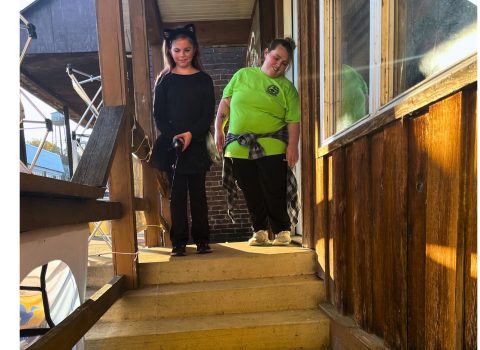As part of the 2024 Tribal Wildlife Grant program, five Tribes in Oregon, Washington, and Idaho received nearly $1 million for new and ongoing conservation projects that benefit plants, wildlife, and habitat of cultural or traditional importance. These projects will support a range of species and habitats in the Pacific Northwest, including elk, salmon, Western snowy plovers and critical coastal habitat.
Since 2001, the U.S. Fish and Wildlife Service’s Tribal Wildlife Grant program has provided opportunities for vital conservation projects on Tribal lands. The Service partners with Tribes to protect threatened and endangered species, restore habitat, and conduct research. The grant program has leveraged millions of dollars to sustain fish and wildlife and help Tribes maintain their heritage.
The summaries below share details of the Pacific Region’s selected proposals:
Shoalwater Bay Indian Tribe: ESA Species Critical Coastal Habitat and Traditional Fisheries Restoration and Monitoring
The Shoalwater Bay Indian Tribe’s reservation is located near Willapa Bay, close to the coastal territory where their ancestors lived for more than 2,000 years. The Tribe has relied on the land, river, seas and skies for food and cultural resources for generations.
The Tribe will use grant funding to protect, restore, and monitor species and habitat within the Tribe’s ancestral lands, including the Western snowy plover and streaked horned lark. Both bird species are listed as threatened under the Endangered Species Act, and the Tribe will increase habitat for the birds and improve access to traditional plants, shellfish, and fish resources for Tribal members. The Tribe will also assess fish habitat and monitor fish populations to support climate resilience and increase opportunities for purposeful cultural connections for the Tribal community.
Nez Perce Tribe: Evaluating Non-Natives in Wallowa Lake, Implications for Sockeye Salmon Reintroduction
The Nimiipuu people have lived on the lands that include the Nez Perce Reservation since time immemorial. Located in north-central Idaho and northeastern Oregon, the Tribe has more than 3,500 citizens, and traditional lifeways include hunting, fishing, gathering, and traditional ceremonies and celebrations.
Sockeye salmon were extirpated from Wallowa Lake in the early 1900s. The Nez Perce Tribe has been involved with reintroduction efforts since the 1990s in hopes of restoring this treaty-reserved fishery. With this year’s Tribal Wildlife Grant funding, the Tribe will investigate the role of non-native species in the Wallowa Lake ecosystem to anticipate potential negative impacts of these species to sockeye salmon reintroduction. The monitoring data will allow early detection of potentially dangerous food web shifts, particularly as Sockeye return to the system, and will also provide data valuable for management of the lake's ESA-listed bull trout population.
Port Gamble S’Klallam Tribe: Monitoring the Dosewallips and Duckabush Elk Herds in Support of Sustained Treaty Hunting Rights
The people of the Port Gamble S’Klallam Tribe were originally known as the Nux Sklai Yem, or Strong People. For thousands of years, the Nux Sklai Yem hunted, gathered and fished from north of the San Juan Islands to south of the Olympic peninsula, living in partnership with the land and its resources.
The Port Gamble S’Klallam Tribe will use 2024 grant funding to establish current data for the elk herds on Tribal lands and write an elk management plan. The Tribe will gather information on the herd growth rate (including reproductive success, herd size, and causes of mortality) for three local elk herds, plus quantify their current distribution and habitat use. The elk management plan will improve monitoring and future management for critically important elk herds, and improve understanding of novel diseases, habitat loss and growing urban development and recreational pressures.
Lummi Nation: Lummi Natural Resources Pinniped Monitoring and Management Project
The Lhaq’temish, or Lummi People, are the original inhabitants of the northern coast of Washington and southern British Columbia. For thousands of years, the Lummi People have relied on the Puget Sound for fishing, hunting, and gathering.
With 2024 Tribal Wildlife Grant money, the Lummi Nation will monitor harbor seal populations and their impacts on salmonid stocks native to the Nooksack River. The main goals of this project are to create the first seal monitoring plan and project for Lummi Nation, provide harbor seal population estimates within Lummi fishing areas, and to collect information on individual seals and sex ratios within the population. As increasing evidence points toward seal populations reaching carrying capacity, projects such as this are necessary to help inform management decisions.
Jamestown S’Klallam Tribe: Study of Pinniped Abundance and Diet Composition, with a Focus on Salmonids, on the Dungeness River Mouth in Washington's Strait of Juan de Fuca
The people of the Jamestown S’Klallam Tribe have lived on the Olympic Peninsula since time immemorial. The S’Klallam, or The Strong People would move from village to village along the coast in the warmer months for fishing, hunting, and gathering, and stay in longhouses during the winter.
Salmon have long been an important food source and trade item for the S’Klallams and neighboring Tribes, and the Dungeness River has been a primary focus of restoration efforts to restore salmon runs.While Dungeness River Chinook salmon runs have improved with ongoing conservation efforts, they are not close to the historic levels. The Tribe will invest 2024 grant dollars to initiate population surveys and dietary analyses on growing seal and sea lion populations to understand how increasing populations affect salmon recovery. Successful implementation of this project will allow the Tribe to begin to quantify if the seals and sea lions are consuming salmonids in or around the mouth of the Dungeness River and assess the significance of the impacts.









